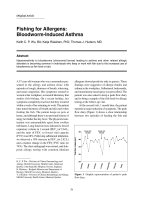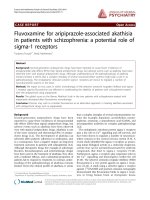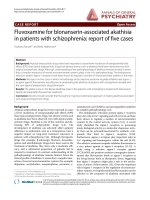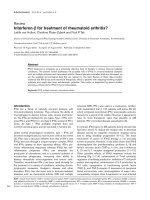Báo cáo y học: " Allowing for spontaneous breathing during high-frequency oscillation: the key for final success" pptx
Bạn đang xem bản rút gọn của tài liệu. Xem và tải ngay bản đầy đủ của tài liệu tại đây (34.46 KB, 2 trang )
Page 1 of 2
(page number not for citation purposes)
Available online />Abstract
In the present issue of Critical Care, van Heerde and colleagues
describe a new technical development (a flow-demand system
during high-frequency oscillation) that may have an important
impact on the future use of high-frequency ventilation in children
and adults. Flow compensation on patient demand seems to
reduce the imposed work of breathing, may therefore increase
patient comfort, and should theoretically allow for maintaining
spontaneous breathing while heavy sedation and muscular
paralysis could be avoided. With further technical development of
this concept, high-frequency oscillation can finally be added to the
techniques of mechanical ventilatory support that maintain, rather
than suppress, spontaneous breathing efforts. Furthermore, this
concept will give high-frequency oscillation the chance to prove its
potential role as primary therapy in patients with acute lung
injury/acute respiratory distress syndrome, the chance to reduce
the incidence of high-frequency oscillation failure for patient or
physician discomfort as reported in so many clinical trials in the
past, the chance to most probably allow successful weaning from
high-frequency oscillation to extubation, and, ultimately, in analogy
to what has been reported from the experience with other ventilator
modes that allow for maintaining spontaneous breathing, the
chance to decrease ventilator days in patients with acute lung
injury/acute respiratory distress syndrome.
High-frequency oscillation ventilators were initially designed for
neonatal application. With the recognition of the role of
ventilator-induced lung injury in the morbidity and mortality of
patients with acute lung injury, there has also been increasing
interest in the use of high-frequency oscillatory ventilation
(HFOV) in adult patients, since it theoretically offers, by design,
an ideal mode for lung protection. The need to suppress
patients’ spontaneous breathing activity with heavy sedation
and muscle paralysis because of patient discomfort, due to a
significantly increased level of imposed work of breathing
(WOB), however, has so far limited the use of HFOV in larger
pediatric patients and in adult patients. In the present issue of
Critical Care, van Heerde and colleagues [1] describe a new
flow-demand system that significantly allows for reducing WOB
during HFOV. This new concept, so far tested in a bench test,
gives the potential for adult intensive care physicians to more
often use HFOV and to further investigate HFOV.
High-frequency oscillatory ventilators can be seen as
continuous positive airway pressure (CPAP) devices that
allow generation of pressure oscillations around a continuous
distending pressure, which will facilitate CO
2
elimination
mainly by accelerating the molecular diffusion processes.
Accepting HFOV as such a ‘super-CPAP’ allows one to
realize that maintaining spontaneous breathing during HFOV
should be nothing other than natural. This maintenance is
possible and well tolerated in newborns, and was probably a
significant contributor to improved pulmonary outcome in this
patient group [2].
As previously shown by van Heerde and colleagues [3], the
imposed WOB for a neonate or an infant (up to a bodyweight
of 10 kg) on HFOV is considerably low (< 0.5 J/l or <1.0 J/l,
respectively) during spontaneous tidal breathing with physio-
logic or smaller tidal volumes between 7 ml/kg to 5 ml/kg – and
this is independent of endotracheal tube size. With increasing
patient size and weight, the imposed WOB increases fast
above 1.0 J/l. Increasing the fresh gas flow rate allows one to
reduce the imposed WOB, but not to an acceptable level in
the large child or in the adult [3] necessitating heavy sedation,
analgesia and often neuromuscular blockade [4]. Using the
new flow-demand system, the imposed WOB can be
considerably reduced to a maximum of 0.5 J/l during shallow or
normal breathing. What could this theoretically mean for HFOV
apart from an improvement of patient comfort?
On the basis of currently available data from the experience
with airway pressure release ventilation or biphasic positive
Commentary
Allowing for spontaneous breathing during high-frequency
oscillation: the key for final success?
Peter C Rimensberger
University Children’s Hospital of Geneva, Pediatric and Neonatal ICU, Geneva, Switzerland
Corresponding author: Peter C Rimensberger,
Published: 31 July 2006 Critical Care 2006, 10:155 (doi:10.1186/cc4993)
This article is online at />© 2006 BioMed Central Ltd
See related research by van Heerde et al. />CPAP = continuous positive airway pressure; HFOV = high-frequency oscillatory ventilation; WOB = work of breathing.
Page 2 of 2
(page number not for citation purposes)
Critical Care Vol 10 No 4 Rimensberger
pressure [5,6] – both methods allowing for unrestricted
spontaneous breathing at any phase of the ventilatory cycle
because of an integrated high-flow or demand valve CPAP
system – it might be postulated that a new high-frequency
oscillation ventilator equipped with a flow-demand system
allowing for unrestricted spontaneous breathing should allow
for less sedation, and should therefore decrease the duration
of mechanical support, decrease the length of stay in the
intensive care unit, and, ultimately, decrease the overall costs
of hospitalization.
The application of HFOV was mainly reported as a rescue
ventilatory mode in adult patients with acute respiratory
distress syndrome who were thought to have failed
conventional ventilation [7]. Outcome results from such
studies cannot reflect the real potential of HFOV as a lung
protective ventilatory mode. With the possibility of
maintaining spontaneous breathing, HFOV could now be
used in patients with mild and/or early forms of acute lung
injury. With the neonatal experience demonstrating that a
lung-protective effect with HFOV requires an early initiation of
HFOV before the lung is damaged, continuing until the lung is
no longer vulnerable to ventilator-induced injury [2,8], an early
transition to HFOV should now be considered in adult acute
lung injury/acute respiratory distress syndrome patients, but
this will need proper clinical testing. Weaning concepts from
HFOV to any form of assisted ventilation or to extubation (as
is already possible in newborns and infants [2]) will also need
re-evaluation.
In patients with acute respiratory distress syndrome, airway
pressure release ventilation with spontaneous breathing has
been shown to improve ventilation–perfusion matching,
intrapulmonary shunting, and arterial oxygenation [9],
indicating recruitment of previously nonventilated lung areas.
HFOV at high lung volumes (i.e. recruited lung), which is
classically achieved by a stepwise increase in continuous
distending pressure to oxygenation and chest X-ray targets,
has been shown superior to HFOV at low lung volumes [10].
This high-volume approach during HFOV is often associated
with relatively high airway pressures, which can cause
hemodynamic compromise necessitating intravascular volume
load; the airway pressure might not, however, be sufficient to
optimally expand the lungs [11].
In the heavily sedated and paralyzed patient, the continuous
distending pressure can be titrated up the inflation limb (to
recruit) and down the deflation limb (to find the least pressure
required to keep the lungs open) of the static pressure–
volume curve, which often allows substantial reduction of
mean airway pressures [2,12,13] while reducing hemo-
dynamic side effects to a maximum. With the possibility of
benefiting from spontaneous breathing for better recruitment
of the dependent lung areas close to the diaphragm, it might
become possible to use lower continuous distending
pressures to achieve the same oxygenation goals. This may
result, together with the effects of the periodic reduction of
intrathoracic pressure resulting from spontaneous breathing,
in better venous return to the heart, in improved ventricular
filling, and therefore in increased cardiac output and oxygen
delivery.
Converting HFOV from a ventilation mode that often requires
suppression of spontaneous breathing in larger children and
adults to a ‘super-CPAP’ system that allows for unrestricted
spontaneous breathing at any phase of the ventilatory cycle
because of an integrated high-flow or demand valve system
will give HFOV the ultimate chance to prove its real potential
for optimal lung protection. The various issues discussed will
now need to be addressed.
Competing interests
The author declares that they have no competing interests.
References
1. van Heerde M, Roubik K, Kopelent V, Plotz FB, Markhorst D:
Unloading work of breathing during high-frequency oscilla-
tory ventilation: a bench study. Crit Care 2006, 10:R103.
2. Rimensberger PC, Beghetti M, Hanquinet S, Berner M: First
intention high-frequency oscillation with early lung volume
optimization improves pulmonary outcome in very low birth
weight infants with respiratory distress syndrome. Pediatrics
2000, 105:1202-1208.
3. Vab Heerde M, van Genderingen HR, Leenhoven T, Roubik K,
Plotz FB, Markhorst DG: Imposed work of breathing during
high-frequency oscillatory ventilation: a bench study. Crit Care
2006, 10:R23.
4. Sessler CN: Sedation, analgesia, and neuromuscular blockade
for high-frequency oscillatory ventilation. Crit Care Med 2005,
33:S209-S216.
5. Putensen C, Zech S, Wrigge H, Zinserling J, Stuber F, Von
Spiegel T, Mutz N: Long term effects of spontaneous breathing
during ventilatory support in patients with acute lung injury.
Am J Respir Crit Care Med 2001, 164:43-49.
6. Putensen C, Hering R, Muders T, Wrigge H: Assisted breathing
is better in acute respiratory failure. Curr Opin Crit Care 2005,
11:63-68.
7. Chan KPW, Stewart TE: Clinical use of high-frequency
oscillatory ventilation patients with acute respiratory distress
syndrome. Crit Care Med 2005, 33(Suppl):S170-S174.
8. Clark RH, Gerstmann DR, Null DM: Prospective randomized
comparison of high frequency oscillatory and conventional
ventilation in respiratory distress syndrome. Pediatrics 1992,
89:5-12.
9. Putensen C, Mutz NJ, Putensen-Himmer G, Zinserling G: Sponta-
neous breathing during ventilatory support improves ventila-
tion-perfusion distributions in patients with acute respiratory
distress syndrome. Am J Respir Crit Care Med 1999, 159:
1241-1248.
10. Bollen CW, Uiterwaal CSPM, van Vught AJ: Cumulative meta-
analysis of high-frequency versus conventional ventilation in
premature neonates. Am J Respir Crit Care Med 2003, 168:
1150-1155.
11. Thome U, Topfer A, Schaller P, Pohlandt F: Effects of mean
airway pressure on lung volume during high-frequency oscil-
latory ventilation of preterm infants. Am J Respir Crit Care Med
1998, 157:1213-1218.
12. Rimensberger PC: ICU cornerstone: high frequency ventilation
is here to stay. Crit Care 2003, 7:342-324.
13. Ferguson ND, Chiche JD, Kacmarek RM, Hallett DC, Mehta S,
Findlay GP, Granton JT, Slutsky AS, Stewart TE: Combining
high-frequency oscillatory ventilation and recruitment maneu-
vers in adults with early acute respiratory distress syndrome:
the Treatment with Oscillation and an Open Lung Strategy
(TOOLS) Trial pilot study. Crit Care Med 2005, 33:479-486.









